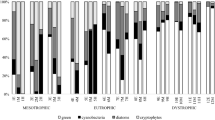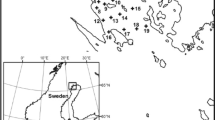Abstract
Using experimental mesocosms, we tested the strength of bottom–up controls by nutrients and top–down controls by an omnivorous fish (Hyphessobrycon bifasciatus; family Characidae), and the interaction between them on the CO2 partial pressure (pCO2) in the surface waters of a tropical humic lake (Lake Cabiúnas, Brazil). The experiment included the addition of nutrients and fish to the mesocosms in a factorial design. Overall, persistent CO2 emissions to the atmosphere, supported by an intense net heterotrophy, were observed in all treatments and replicates over the 6-week study period. The CO2 efflux (average ± standard error) integrated over the experiment was similar among the control mesocosms and those receiving only fish or only nutrients (309 ± 2, 303 ± 16, and 297 ± 17 mmol CO2 m−2 day−1, respectively). However, the addition of nutrients in the presence of fish resulted in a high algal biomass and daytime net autotrophy, reducing the CO2 emissions by 35% (by 193 ± 7 mmol CO2 m−2 day−1). These results indicate that high CO2 emissions persist following the eutrophication of humic waters, but that the magnitude of these emissions might depend on the structure of the food web. In conclusion, fish and nutrients may act in a synergistic manner to modulate persistent CO2 emissions from tropical humic lakes.





Similar content being viewed by others
References
Amado AM, Cotner JB, Suhett AL, Esteves FD, Bozelli RL, Farjalla VF (2007) Contrasting interactions mediate dissolved organic matter decomposition in tropical aquatic ecosystems. Aquat Microb Ecol 49:25–34
American Public Health Association (APHA) (1992) Standard methods for the examination of water and wastewater, vol 18. APHA, Washington, DC
Archer CL, Jacobson MZ (2005) Evaluation of global wind power. J Geophys Res Atmos 110:D12110. doi:10.1029/2004jd005462
Benson BB, Krause DJr (1984) The concentration and isotopic fractionation of oxygen dissolved in freshwater and seawater in equilibrium with the atmosphere. Limnol Oceanogr 29:620–632
Beutler M et al (2002) A fluorometric method for the differentiation of algal populations in vivo and in situ. Photosynth Res 72:39–53
Biddanda B, Ogdahl M, Cotner J (2001) Dominance of bacterial metabolism in oligotrophic relative to eutrophic waters. Limnol Oceanogr 46:730–739
Carignan R, Planas D, Vis C (2000) Planktonic production and respiration in oligotrophic Shield lakes. Limnol Oceanogr 45:189–199
Carmouze JP, Knoppers B, Vasconcelos P (1991) Metabolism of a subtropical Brazilian lagoon. Biogeochemistry 14:129–148
Carneiro LS (2008) Efeito de peixes onívoros sobre a estrutura e estabilidade de cadeias tróficas aquáticas (in Portuguese). PhD thesis. Federal University of Rio de Janeiro, Rio de Janeiro
Chrzanowski TH, Grover JP (2001) Effects of mineral nutrients on the growth of bacterio- and phytoplankton in two southern reservoirs. Limnol Oceanogr 46:1319–1330
Cole JJ, Caraco NF (1998) Atmospheric exchange of carbon dioxide in a low-wind oligotrophic lake measured by the addition of SF6. Limnol Oceanogr 43:647–656
Cole JJ, Caraco NF, Kling GW, Kratz TK (1994) Carbon-dioxide supersaturation in the surface waters of lakes. Science 265:1568–1570
Cole JJ, Pace ML, Carpenter SR, Kitchell JF (2000) Persistence of net heterotrophy in lakes during nutrient addition and food web manipulations. Limnol Oceanogr 45:1718–1730
Cole JJ et al (2007) Plumbing the global carbon cycle: integrating inland waters into the terrestrial carbon budget. Ecosystems 10:171–184
Coutinho AB, Aguiaro T, Branco CWC, Albuquerque EF, Souza-Filho IF (2000) Feeding of Hyphessobrycon bifasciatus Ellis, 1911 (Osteichthyes, Characidae) in Lake Cabiúnas, Macaé, RJ. Acta Limnol Bras 12:45–54
Drenner RW, Smith JD, Threlkeld ST (1996) Lake trophic state and the limnological effects of omnivorous fish. Hydrobiologia 319:213–223
Duarte CM, Agusti S (1998) The CO2 balance of unproductive aquatic ecosystems. Science 281:234–236
Duarte CM, Prairie YT (2005) Prevalence of heterotrophy and atmospheric CO2 emissions from aquatic ecosystems. Ecosystems 8:862–870
Fee EJ (1979) Relation between Lake Morphometry and primary productivity and its use in interpreting whole-lake eutrophication experiments. Limnol Oceanogr 24:401–416
Garcia LV (2004) Escaping the Bonferroni iron claw in ecological studies. Oikos 105:657–663
Guariento RD, Carneiro LS, Caliman A, Bozelli RL, Leal JJF, Esteves FDA (2010) Interactive effects of omnivorous fish and nutrient loading on net productivity regulation of phytoplankton and periphyton. Aquat Biol 10:273–282
Gudasz C, Bastviken D, Steger K, Premke K, Sobek S, Tranvik LJ (2010) Temperature-controlled organic carbon mineralization in lake sediments. Nature 466:U473–U478
Hanson PC, Bade DL, Carpenter SR, Kratz TK (2003) Lake metabolism: relationships with dissolved organic carbon and phosphorus. Limnol Oceanogr 48:1112–1119
Lennon JT (2004) Experimental evidence that terrestrial carbon subsidies increase CO2 flux from lake ecosystems. Oecologia 138:584–591
Marotta H, Duarte CM, Sobek S, Enrich-Prast A (2009a) Large CO2 disequilibria in tropical lakes. Global Biogeochem Cycles 23:GB4022. doi:10.1029/2008GB003434
Marotta H, Paiva LT, Petrucio MM (2009b) Changes in thermal and oxygen stratification pattern coupled to persistence of CO2 outgassing in shallow lakes of the surroundings of Atlantic Tropical Forest, Brazil. Limnology 10:195–202
Marotta H, Duarte CM, Meirelles-Pereira F, Bento L, Esteves FA, Enrich-Prast A (2010a) Long-term variability of CO2 in two shallow tropical lakes experiencing episodic eutrophication and acidification events. Ecosystems 13:382–392
Marotta H, Duarte CM, Pinho L, Enrich-Prast A (2010b) Rainfall leads to increased pCO2 in Brazilian coastal lakes. Biogeosciences 7:1607–1614
McCollum EW, Crowder LB, McCollum SA (1998) Complex interactions of fish, snails, and littoral zone periphyton. Ecology 79:1980–1994
Moss B, Stephen D, Balayla DM, Becares E, Collings SE et al (2004) Continental-scale patterns of nutrient and fish effects on shallow lakes: synthesis of a pan-European mesocosm experiment. Freshw Biol 49:1633–1649
Odum HT (1956) Primary production in flowing waters. Limnol Oceanogr 1:102–117
Okun N, Brasil J, Attayde JL, Costa IAS (2008) Omnivory does not prevent trophic cascades in pelagic food webs. Freshw Biol 53:129–138
Panosso R, Attayde JL, Muehe D (1998) Morphometry of the Imboassica, Cabiúnas and Carapebus Lagoons: implications for its functioning and management (original in portuguese). In: Esteves FA (ed) Ecology of coastal lagoons (original in Portuguese). NUPEM/UFRJ, Macaé, pp 91–108
Polis GA (1999) Why are parts of the world green? Multiple factors control productivity and the distribution of biomass. Oikos 86:3–15
Prairie YT, Bird DF, Cole JJ (2002) The summer metabolic balance in the epilimnion of southeastern Quebec lakes. Limnol Oceanogr 47:316–321
Schindler DE, Carpenter SR, Cole JJ, Kitchell JF, Pace ML (1997) Influence of food web structure on carbon exchange between lakes and the atmosphere. Science 277:248–251
Simberloff D (2003) Communities and ecosystems impacts of single-species extinctions. In: Kareiva P, Levin SA (eds) The importance of species: perspectives on expendability and triage. Princeton University Press, Princeton
Sobek S, Tranvik LJ, Cole JJ (2005) Temperature independence of carbon dioxide supersaturation in global lakes. Global Biogeochem Cycles 19:1–10
Stephen D, Balayla DM, Bécares E, Collings SE, Fernández-Aláez C, Fernández-Aláez M, Ferriol C et al (2004) Continental-scale patterns of nutrient and fish effects on shallow lakes: introduction to a pan-European mesocosm experiment. Freshw Biol 49:1517–1524
Stumm W, Morgan JJ (1996) Aquatic chemistry:chemical equilibria and rates in natural waters, vol 3. Wiley, New York
Wanninkhof R (1992) Relationship between wind-speed and gas-exchange over the ocean. J Geophys Res Oceans 97:7373–7382
Wanninkhof R, Knox M (1996) Chemical enhancement of CO2 exchange in natural waters. Limnol Oceanogr 41:689–697
Weiss RF (1974) Carbon dioxide in water and seawater: the solubility of a non-ideal gas. Mar Chem 2:203–215
Acknowledgments
This research was funded by the Brazilian government (CAPES/MEC). The authors received financial support from the Rio de Janeiro State Science Foundation (FAPERJ). This project is also a contribution to the project PQ 307734/2006-4 funded by the Brazilian National Science Foundation (CNPq). We thank the Macaé Ecological Research Centre (NUPEM/UFRJ) for logistic support and L. Carneiro, A. Caliman, R. D. Guariento, and A. Rocha for their invaluable help in the field and contributions in scientific discussions.
Author information
Authors and Affiliations
Corresponding author
Additional information
Communicated by Joel Trexler.
Rights and permissions
About this article
Cite this article
Marotta, H., Duarte, C.M., Guimarães-Souza, B.A. et al. Synergistic control of CO2 emissions by fish and nutrients in a humic tropical lake. Oecologia 168, 839–847 (2012). https://doi.org/10.1007/s00442-011-2131-9
Received:
Accepted:
Published:
Issue Date:
DOI: https://doi.org/10.1007/s00442-011-2131-9




